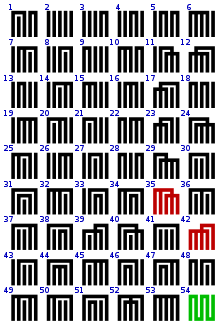54 (number)
| ||||
|---|---|---|---|---|
| Cardinal | fifty-four | |||
| Ordinal | 54th (fifty-fourth) | |||
| Factorization | 2 × 33 | |||
| Divisors | 1, 2, 3, 6, 9, 18, 27, 54 | |||
| Greek numeral | ΝΔ´ | |||
| Roman numeral | LIV | |||
| Binary | 1101102 | |||
| Ternary | 20003 | |||
| Senary | 1306 | |||
| Octal | 668 | |||
| Duodecimal | 4612 | |||
| Hexadecimal | 3616 | |||
| Chinese numeral | 五十四 | |||
| Japanese numeral | 五十四 | |||
| Morse code | ......... _ | |||
54 (fifty-four; LIV) is the natural number following 53 and preceding 55. 54 is an even number and a composite number.
In mathematics
[edit]Number theory
[edit]
- 54 is an abundant number and a semiperfect number, like all other multiples of 6.[1]
- An Aliquot sum of 66
- It is twice the third power of three, 33 + 33 = 54, and hence is a Leyland number.[2]
- 54 is the smallest number that can be written as the sum of three positive squares in more than two different ways: 72 + 22 + 12 = 62 + 32 + 32 = 52 + 52 + 22 = 54.[3][4]
- It is a 19-gonal number,[5]
- 54 is the only non-trivial Neon Number in Power 9: 549 = 3,904,305,912,313,344; 3 + 9 + 0 + 4 + 3 + 0 + 5 + 9 + 1 + 2 + 3 + 1 + 3 + 3 + 4 + 4 = 54
- A humble number
- An evil number[6]
Trigonometry
[edit]- The sine of an angle of 54 degrees is half the golden ratio.
Graph theory
[edit]- The Holt graph has 54 edges.
Recreational mathematics
[edit]- In base 10, 54 is a Harshad number.[7]
- Aban number
- Eban number
List of basic calculations
[edit]| Multiplication | 1 | 2 | 3 | 4 | 5 | 6 | 7 | 8 | 9 | 10 | 11 | 12 | 13 | 14 | 15 | 16 | 17 | 18 | 19 | 20 |
|---|---|---|---|---|---|---|---|---|---|---|---|---|---|---|---|---|---|---|---|---|
| 54 × x | 54 | 108 | 162 | 216 | 270 | 324 | 378 | 432 | 486 | 540 | 594 | 648 | 702 | 756 | 810 | 918 | 972 | 1026 | 1080 | 1134 |
In other fields
[edit]
In ASCII, 54 is the decimal for the number 6 character.[8]
With regards to sports, in golf, a score of 54 on a par 72 course is colloquially referred to as a perfect round. This score has never been achieved in competition. In racquetball, 54 is used when a player is defeated 3 games in a row.
A famous joke from The Hitchhiker's Guide to the Galaxy by Douglas Adams concerned the "Answer to the Ultimate Question of Life, the Universe, and Everything," which was 42. Eventually, one character's attempt to divine the Ultimate Question elicited "What do you get if you multiply six by nine?" The mathematical answer is 54, and the story explained the discrepancy. Some readers who were trying to find a deeper meaning in the passage soon noticed a certain veracity when using base-13; 610 × 910 = 5410, which can be expressed as 4213 (i.e. the decimal expression 54 is encoded as 42 in base-13).[9] When confronted with this, Adams claimed that it was a mere coincidence, stating that "I may be a sorry case, but I don't write jokes in base 13."[10]
See also
[edit]- 54 (disambiguation)
- 45 (number) – 54 reversed
References
[edit]- ^ "Sloane's A005835 : Pseudoperfect (or semiperfect) numbers". The On-Line Encyclopedia of Integer Sequences. OEIS Foundation. Retrieved 2016-05-30.
- ^ "Sloane's A076980 : Leyland numbers". The On-Line Encyclopedia of Integer Sequences. OEIS Foundation. Retrieved 2016-05-30.
- ^ Sloane, N. J. A. (ed.). "Sequence A025331". The On-Line Encyclopedia of Integer Sequences. OEIS Foundation.
- ^ Sloane, N. J. A. (ed.). "Sequence A025323". The On-Line Encyclopedia of Integer Sequences. OEIS Foundation.
- ^ "Sloane's A051871 : 19-gonal numbers". The On-Line Encyclopedia of Integer Sequences. OEIS Foundation. Retrieved 2016-05-30.
- ^ Sloane, N. J. A. (ed.), "Sequence A001969 (Evil numbers: numbers with an even number of 1's in their binary expansion)", The On-Line Encyclopedia of Integer Sequences, OEIS Foundation
- ^ "Sloane's A005349 : Niven (or Harshad) numbers". The On-Line Encyclopedia of Integer Sequences. OEIS Foundation. Retrieved 2016-05-30.
- ^ "ASCII Code 54 - Six". www.ascii-code.com. Retrieved 2025-01-03.
- ^ Adams, Douglas (1985). Perkins, Geoffrey (ed.). The Original Hitchhiker Radio Scripts. London: Pan Books. p. 128. ISBN 0-330-29288-9.
- ^ Diaz, Jesus. "Today Is 101010: The Ultimate Answer to the Ultimate Question". io9. Archived from the original on 26 May 2017. Retrieved 8 May 2017.
